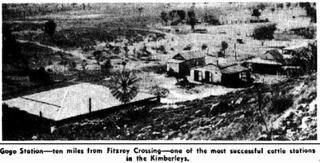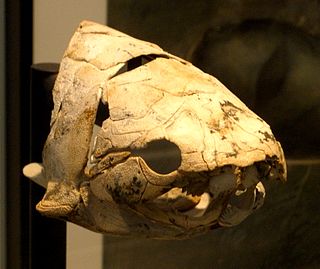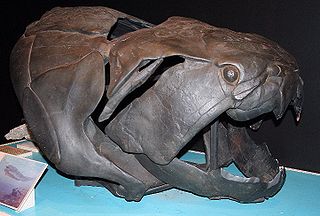
Arthrodira is an order of extinct armored, jawed fishes of the class Placodermi that flourished in the Devonian period before their sudden extinction, surviving for about 50 million years and penetrating most marine ecological niches. Arthrodires were the largest and most diverse of all groups of placoderms.

Brachythoraci is an extinct suborder of arthrodire placoderms, armored fish most diverse during the Devonian.

Rolfosteus is an extinct monospecific genus of arthrodire placoderm from the Early Frasnian stage of the Late Devonian period, found at the Gogo Formation of Western Australia.

The Gogo Formation in the Kimberley region of Western Australia is a Lagerstätte that exhibits exceptional preservation of a Devonian reef community. The formation is named after Gogo Station, a cattle station where outcrops appear and fossils are often collected from, as is nearby Fossil Downs Station.

Eastmanosteus is a fossil genus of dunkleosteid placoderms. It was closely related to the giant Dunkleosteus, but differed from that genus in size, in possessing a distinctive tuberculated bone ornament, a differently shaped nuchal plate and a more zig-zagging course of the sutures of the skull roof.

Incisoscutum is an extinct genus of arthrodire placoderm from the Early Frasnian Gogo Reef, from Late Devonian Australia. The genus contains two species I. ritchiei, named after Alex Ritchie, a palaeoichthyologist and senior fellow of the Australian Museum, and I. sarahae, named after Sarah Long, daughter of its discoverer and describer, John A. Long.

Mcnamaraspis is an extinct monospecific genus of arthrodire placoderm that inhabited the ancient reef system of north Western Australia during the Frasnian epoch of the Late Devonian period. The type specimen was found and described by John A. Long from the Gogo Formation near Fitzroy Crossing. This fossil fish showed new anatomical features in arthrodires, like the well-preserved annular (ring-shaped) cartilages of the snout, previously inferred to be present by Erik Stensiö of Sweden. It is occasionally referred to as "The Gogo Fish" after the locale the holotype was excavated from.
Camuropiscidae is a family of mostly small, bullet or spindle-shaped extinct arthrodire placoderms from the Late Devonian. With the exception of the snub-nosed Simosteus, camuropiscid placoderms are characterized by an elongated, tubular snout. The entire family is restricted to the Frasnian Gogo Reef Formation of Australia.

Fallacosteus is an extinct monospecific genus of arthrodire placoderm from the Early Frasnian stage of the Late Devonian period, found at the Gogo Formation of Kimberley, Western Australia. As with almost all other camuropiscids, F. turneri had an elongated snout that may have enhanced its hydrodynamic streamlining.

Camuropiscis is an extinct genus of arthrodire placoderm from the Early Frasnian stage of the Late Devonian period, found at the Gogo Formation of Kimberley, Western Australia. The species of Camuropiscis had a flattened, elongated snout that may have aided in enhancing its hydrodynamic streamlining.

Tubonasus is an extinct monospecific genus of long-snouted arthrodire placoderm from the Early Frasnian stage of the Late Devonian period, found at the Gogo Formation of Kimberley, Western Australia.

Latocamurus is an extinct monospecific genus of flat-nosed arthrodire placoderm from the Early Frasnian stage of the Late Devonian period, found at the Gogo Formation of Kimberley, Western Australia.

Harrytoombsia is an extinct genus of arthrodire placoderm from the Early Frasnian stage of the Late Devonian period. Fossils are found from Kimberley, Australia. It was a fast-swimming predator, and it had sharp blades of enamel-like material around the outer edge of the jaw for catching prey.

Eubrachythoraci is an extinct clade of arthrodire placoderms within the suborder Brachythoraci, armored fish most diverse during the Devonian. Most are considered to be pelagic long-distance swimmers, leading to their widespread distribution beginning from at least the Middle Devonian period.

Pachyosteomorphi is an extinct clade of arthrodire placoderms within the Eubrachythoraci, armored fish most diverse during the Devonian. Most are considered to be pelagic long-distance swimmers, leading to their widespread distribution beginning from at least the Middle Devonian period.
Compagopiscis is an extinct genus of placoderm known from the Gogo Formation. It lived in the Upper Devonian of Western Australia. The genus is monotypic, with its only species being Compagopiscis croucheri.

Coccosteomorphi is an extinct clade of arthrodire placoderms within the Eubrachythoraci, armored fish most diverse during the Devonian. Most are considered to be pelagic long-distance swimmers, leading to their widespread distribution beginning from at least the Middle Devonian period.
Torosteus is an extinct genus of arthrodire placoderm from the Early Frasnian stage of the Late Devonian period. Fossils are found in the Kimberley region of Australia.
Bullerichthys is an extinct monospecific genus of arthrodire placoderm from the Early Frasnian stage of the Late Devonian period. Fossils are found in the Gogo Formation of the Kimberley region of Australia. It was thought to be durophagous, meaning that it preyed upon hard-shelled creatures such as mollusks.
Kendrickichthys is an extinct monospecific genus of arthrodire placoderm from the Early Frasnian stage of the Late Devonian period. Fossils are found in the Gogo Formation of the Kimberley region of Australia. It was thought to be durophagous, meaning that it preyed upon hard-shelled creatures such as mollusks.























